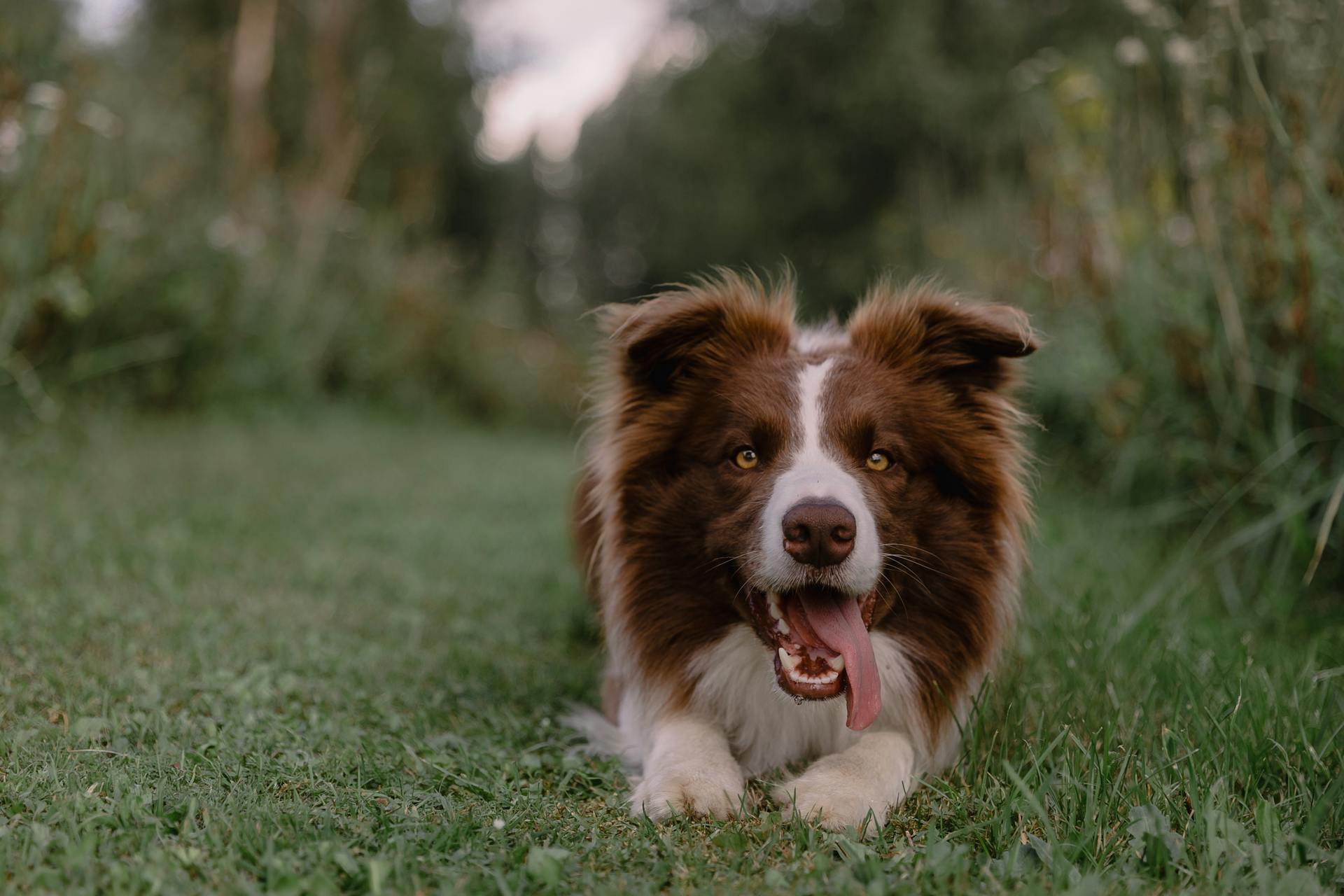
Dogs mature faster than humans, which is why their lifespan is often referred to as "dog years." A dog's lifespan is typically calculated by multiplying their age by seven, but this is not an exact science.
The lifespan of a dog is affected by its breed, size, and genetics. Small breeds tend to live longer than large breeds, with some living up to 17-20 years or more.
Factors such as diet, exercise, and health conditions also play a significant role in determining a dog's lifespan. Proper care and attention can help extend a dog's life.
A dog's rate of aging is also influenced by its metabolic rate, with smaller dogs aging more slowly than larger dogs.
Curious to learn more? Check out: Bird Years
Factors Affecting Lifespan
Large dogs tend to age at an accelerated pace, with their lives seeming to "unwind in fast motion." This is according to researcher Cornelia Kraus, an evolutionary biologist at the University of Göttingen in Germany.
Every 4.4 pounds of body mass reduces a dog's life expectancy by about a month. This is a surprising phenomenon, as large mammals like elephants and whales tend to live longer than small ones.
Larger dogs may succumb to age-related illnesses sooner, which could be a contributing factor to their shorter lifespan.
Studies and Research
Researchers have made significant progress in understanding how to calculate dog age, with a 2019 study by the University of California San Diego developing a formula to adjust dogs' ages to "human years".
The formula, which is based on DNA methylation, involves multiplying the natural logarithm of the dog's age by 16 and adding 31. However, this formula may not be entirely accurate due to the limited sample size of a single breed, Labrador Retrievers.
Despite this limitation, the study provides a useful starting point for understanding dog aging, and its results can be calculated using a natural logarithm calculator.
The American Veterinary Medical Association (AVMA) also provides guidance on dog aging, noting that cats and small dogs are generally considered "senior" at seven years old, while larger-breed dogs tend to have shorter lifespans and are often considered senior at five to six years of age.
Here's an interesting read: Black Lab Dog Years
Researchers' Numbers Explained

The American Veterinary Medical Association (AVMA) says that cats and small dogs are generally considered "senior" at seven years old.
The "senior" classification is based on the fact that pets age faster than people, and veterinarians start seeing more age-related problems in these pets.
Dogs do not age at a rate of 7 human years for each year in dog years, contrary to popular belief.
Larger-breed dogs tend to have shorter lifespans compared to smaller breeds and are often considered senior when they are 5 to 6 years of age.
The Great Dane Club of America reports that the average life expectancy for Great Danes is about 7–10 years.
A 4-year-old Great Dane would already be 35 in human years, according to this average life expectancy.
A unique perspective: Great Pyrenees Dog of the Year
A Fresh Look
The "one dog year equals seven human years" myth has been debunked, and it's time to look at dog aging in a fresh light.
The concept of dog years is more complex than a simple ratio.
Taking care of your pet's health is key to canine longevity, regardless of their age in human years.
Whether your dog is 7 or 70 in human years, they still need love, attention, and plenty of belly rubs to live a long and happy life.
Calculating Dog Age
Calculating dog age can be a bit tricky, but there are some general guidelines to follow. The American Veterinary Medical Association suggests that the first year of a medium-sized dog's life is equivalent to about 15 human years.
There are a few different methods to calculate dog age, and which one to use depends on the size and breed of your dog. For example, smaller dogs like Pomeranians age more slowly and have longer life spans.
One simple method is to use the following equation: a dog's age (in years) x 7 = Age in "dog years." However, this is just a rough estimate and doesn't take into account the dog's size and breed.
A more accurate comparison of human vs. canine age takes into consideration the dog's size and breed. Smaller dogs age more slowly and have longer life spans, while larger dogs age more quickly and have shorter life spans.
Here's a breakdown of how dog age is calculated based on size:
Keep in mind that this is just a rough estimate, and the actual age of your dog will depend on many factors, including their breed, size, and overall health. If you're unsure about your dog's age, it's always best to consult with a veterinarian for an accurate estimate.
Signs of Aging and Longevity
Dogs typically start showing signs of aging around 5 to 10 years old, with larger breeds aging faster than smaller ones.
By 7 months, your dog will have all their permanent teeth, and by 1 to 2 years old, their teeth may appear duller and slightly yellowed.
Indicators that your dog is reaching the senior stage include graying hair, poor eyesight or cloudy eyes, trouble hearing, stiff muscles and joints or arthritis, lower activity level, and behavioral changes such as anxiety, confusion, accidents in the house, and irritability.
Smaller breeds might not have noticeable changes until 7 or 8 years, while larger breeds may show signs of aging around 5 or 6 years old.
You can ask your veterinarian for an accurate estimate of your dog's age in dog years if you're unsure.
Here's a rough estimate of when dogs typically reach different stages of aging:
Signs of Aging
As your furry friend ages, you may notice some visible signs. By 7 months, your dog will have all their permanent teeth, while by 1 to 2 years old, their teeth may appear duller and slightly yellowed.
Dental wear and tear is a common issue that starts to show around 5 to 10 years of age. You may notice your dog's teeth looking a bit worn down.
Graying hair is another indicator that your dog is getting older. This can start to happen at any age, but it's more noticeable in older dogs.

Poor eyesight or cloudy eyes can also be a sign of aging in dogs. This can start to happen around 5 to 10 years of age.
Trouble hearing is another common issue that can affect older dogs. This can start to happen around 5 to 10 years of age.
Stiff muscles and joints or arthritis can make it harder for your dog to move around. This can start to happen around 5 to 10 years of age.
Here's a rough guide to when you might start to notice these signs of aging in your dog:
Keep in mind that every dog is different, and the age at which you'll notice these signs can vary depending on your dog's individual health and genetics. If you're unsure, it's always a good idea to consult with your veterinarian for an accurate estimate of your dog's age in dog years.
Living Longer
By understanding how breed, size, and lifestyle influence aging in dogs, you can tailor their care to meet their needs at every life stage.
Forever may not be possible, but there are ways to help your dog live a longer and happier life.
Some breeds are more prone to certain health issues due to their genetic makeup, so it's essential to research your dog's breed and take preventative measures.
Dogs of smaller size tend to live longer than larger breeds, with some smaller breeds living up to 15-20 years or more.
A dog's lifestyle can also impact their longevity, with regular exercise and mental stimulation being crucial for a happy and healthy life.
By understanding your dog's individual needs and tailoring their care accordingly, you can help them live a longer and more fulfilling life.
What Is Considered Old?
As we age, our furry friends do too. What is considered old for a dog varies depending on their size.
Small dogs become seniors at 11-12 years of age, while their medium-sized counterparts reach senior status at 10 years old. Larger dogs, on the other hand, become seniors at 8 years of age.
Here's a breakdown of what's considered old for different sized dogs:
This means that a Great Dane becomes a senior citizen far earlier than a Pomeranian.
Frequently Asked Questions
Is 1 year in dog years 7?
According to the American Veterinary Medical Association, 1 year in dog years is not 7, but rather a dog's first year is equivalent to about 15 human years, with each subsequent year being approximately 5 human years.
How old is a dog 7 years?
A 7-year-old dog is equivalent to a 49-year-old human in "dog years." This conversion helps estimate a dog's aging stage based on human years.
Sources
- https://www.akc.org/expert-advice/health/how-to-calculate-dog-years-to-human-years/
- https://vcahospitals.com/know-your-pet/how-old-is-old-comparing-dog-age-to-human-age
- https://www.petmd.com/dog/general-health/how-old-is-my-dog
- https://www.pumpkin.care/blog/dog-age-chart/
- https://www.almanac.com/dog-age-chart-dog-years-human-years
Featured Images: pexels.com


